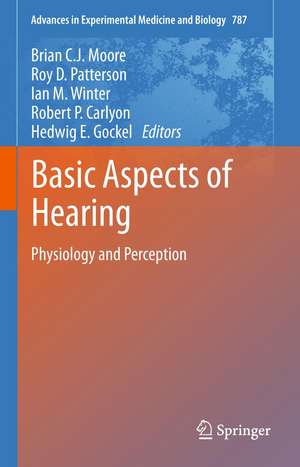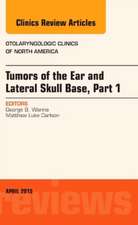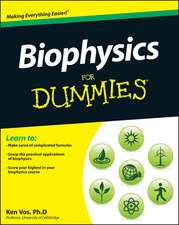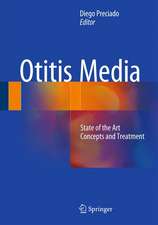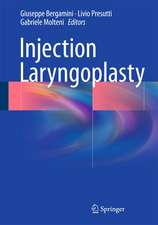Basic Aspects of Hearing: Physiology and Perception
Editat de Brian C.J. Moore, Roy D. Patterson, Ian M. Winter, Robert P. Carlyon, Hedwig E. Gockelen Limba Engleză Paperback – 23 iun 2015
Basic Aspects of Hearing: Physiology and Perception includes the best papers from the 2012 International Symposium on Hearing. Over 50 chapters focus on the relationship between auditory physiology, psychoacoustics, and computational modeling.
| Toate formatele și edițiile | Preț | Express |
|---|---|---|
| Paperback (1) | 1425.25 lei 6-8 săpt. | |
| Springer – 23 iun 2015 | 1425.25 lei 6-8 săpt. | |
| Hardback (1) | 1431.30 lei 6-8 săpt. | |
| Springer – 29 mai 2013 | 1431.30 lei 6-8 săpt. |
Preț: 1425.25 lei
Preț vechi: 1500.26 lei
-5% Nou
Puncte Express: 2138
Preț estimativ în valută:
272.73€ • 291.63$ • 227.39£
272.73€ • 291.63$ • 227.39£
Carte tipărită la comandă
Livrare economică 17 aprilie-01 mai
Preluare comenzi: 021 569.72.76
Specificații
ISBN-13: 9781493900183
ISBN-10: 1493900188
Pagini: 580
Ilustrații: XXVII, 549 p.
Dimensiuni: 155 x 235 x 30 mm
Greutate: 0.8 kg
Ediția:2013
Editura: Springer
Colecția Springer
Locul publicării:New York, NY, United States
ISBN-10: 1493900188
Pagini: 580
Ilustrații: XXVII, 549 p.
Dimensiuni: 155 x 235 x 30 mm
Greutate: 0.8 kg
Ediția:2013
Editura: Springer
Colecția Springer
Locul publicării:New York, NY, United States
Public țintă
GraduateCuprins
Topic 1: Peripheral processing.- Chapter 1. Mosaic evolution of the mammalian auditory periphery.- Chapter 2. A computer model of the auditory periphery and its application to the study of hearing.- Chapter 3. A probabilistic account of absolute auditory thresholds and its possible physiological basis.- Chapter 4. Cochlear compression: Recent insights from behavioural experiments.- Chapter 5. Improved psychophysical methods to estimate peripheral gain and compression.- Chapter 6. Contralateral efferent regulation of human cochlear tuning: Behavioural observations and computer model simulations.- Chapter 7. Modeling effects of precursor duration on behavioral estimates of cochlear gain.- Chapter 8. Is overshoot caused by an efferent reduction in cochlear gain?.- Chapter 9. Accurate estimation of compression in simultaneous masking enables the simulation of hearing impairment for normal-hearing listeners.- Chapter 10. Modelling the distortion produced by cochlear compression.- Topic 2: Temporal fine structure and pitch.- Chapter 11. How independent are the pitch and the interaural-time-difference mechanisms that rely on temporal fine structure information?.- Chapter 12. On the limit of neural phase-locking to fine-structure in humans.- Chapter 13. Effects of sensorineural hearing loss on temporal coding of harmonic and inharmonic tone complexes in the auditory nerve.- Chapter 14. A glimpsing account of the role of temporal fine structure information in speech recognition.- Chapter 15. Assessing the possible role of frequency-shift detectors in the ability to hear out partials in complex tones.- Chapter 16. Pitch perception: Dissociating frequency from fundamental-frequency discrimination.- Chapter 17. Pitch perception for sequences of impulse responses whose scaling alternates at every cycle.- Chapter 18. Putting the tritone paradox into context: insights from neural population decoding and human psychophysics.- Topic 3: Enhancement and perceptual compensation.-Chapter 19. Spectral and level effects in auditory enhancement.- Chapter 20. Enhancement of increments in spectral amplitude: further evidence for a mechanism based on central adaptation.- Chapter 21. Differential sensitivity to appearing and disappearing objects in complex acoustic scenes.- Chapter 22. Perceptual compensation when isolated test words are heard in room reverberation.- Chapter 23. A new approach to sound source identification.- Topic 4: Binaural processing.- Chapter 24. Maps of ITD in the Nucleus Laminaris of the Barn Owl.- Chapter 25. The influence of the envelope waveform on binaural tuning of neurons in the inferior colliculus and its relation to binaural perception.- Chapter 26. No evidence for ITD-specific adaptation in the frequency following response.- Chapter 27. Interaural time difference thresholds as a function of frequency.- Chapter 28. Interaural time processing when stimulus bandwidth differs at the two ears C.A. Brown,.- Chapter 29. Neural correlates of the perception of sound source separation.- Chapter 30. When and how envelope “rate-limitations” affect processing of interaural temporal disparities conveyed by high-frequency stimuli.- Chapter 31. The sound source distance dependence of the acoustical cues to location and their encoding by neurons in the inferior colliculus – implications for the Duplex theory.- Chapter 32. Cochlear contributions to the precedence effect.- Chapter 33. Off-frequency BMLD: the role of monaural processing.- Chapter 34. Measuring the apparent width of auditory sources in normal and impaired hearing.- Chapter 35. Psychophysics of human echolocation.- Topic 5: Speech and temporal processing.- Chapter 36. Formant-frequency variation and its effects on across-formant grouping in speech perception.- Chapter 37. Do we need STRFs for cocktail parties? - On the relevance of physiologically motivated features for human speech perception derived from automatic speech recognition.- Chapter 38. Modeling speechintelligibility in adverse conditions.- Chapter 39. Better temporal neural coding with cochlear implants in awake animals.- Chapter 40. Effects of auditory nerve refractoriness and adaptation on auditory perception.- Chapter 41. Robust cortical encoding of slow temporal modulations of speech.- Chapter 42. Wideband monaural envelope correlation perception.- Chapter 43. Detection thresholds for amplitude modulations of tones in budgerigar (Melopsittacus undulatus).- Chapter 44. Phase discrimination ability in Mongolian gerbils provides evidence for possible processing mechanism of mistuning detection.- Topic 6: Auditory cortex and beyond. Chapter 45.- Stimulus-specific adaptation beyond pure tones.- Chapter 46. Mapping tonotopy in human auditory cortex.- Chapter 47. Cortical activity associated with the perception of temporal asymmetry in ramped and damped noises.- Chapter 48. Cortical representation of the combination of monaural and binaural unmasking.- Chapter 49. Processing of short auditory stimuli: The Rapid Audio Sequential Presentation paradigm (RASP).- Chapter 50. Integration of auditory and tactile inputs in musical meter perception.- Chapter 51. A dynamic system for the analysis of the acoustic features and valence of aversive sounds in the human brain.- Topic 7: Auditory scene analysis.- Chapter 52. Can comodulation masking release occur when frequency changes would promote perceptual segregation of the on-frequency and flanking bands?.- Chapter 53. Illusory auditory continuity despite neural evidence to the contrary.- Chapter 54. High-acuity spatial stream segregation .- Chapter 55. How early aging and environment interact in everyday listening: From brainstem to behaviour through modeling.- Chapter 56. Energetic and informational masking in a simulated restaurant environment.- Chapter 57. A computational model for the dynamic aspects of primitive auditory scene analysis.- Chapter 58. A naturalistic approach to the cocktail party.- Chapter 59. Temporal coherence and the streaming of complex sounds.- Index.
